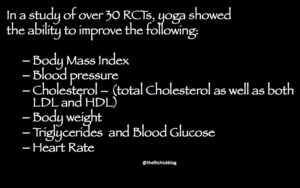The below slide information is just ONE of the myriad of recent research reports on the benefits of a consistent yoga practice:

And those improved factors listed above are but a FRACTION of the proven benefits.
A little background is in order:
RCT = Random Controlled Trial
When a study is categorized as an RCT it holds more “weight” than, say, a case study, magazine (or online) report, or similar because it removes the bias by randomly assigning study participants to either the “treatment” or the placebo (control) groups. If it’s a “double bias” study, neither the researchers nor the participants are keyed on who’s in or doing what.
A meta-analysis is even BETTER (aka more credible) because it studies multiple RCTs!
Why is this important?
Because when we use search engines like Google to gather information we might be directed to websites with research claims. Anyone can study anything and call it “research”. Heck, some companies do it all the time as a means to garner interest or make it look like their product or service is superior.
While intensely popular, yoga still isn’t seen as “mainstream” and until recently there was a real absence of yoga research. In the last 10 years or so, that has definitely changed. Even Yoga Alliance has a page on their site dedicated to yoga research.
PubMed is a fantastic website to go to with close to 5 million credible research reports. And every year more and more yoga studies are being published.
So the next time someone questions whether yoga is REALLY worthwhile or a legitimate activity, hit ’em up with some research. As they say, “the science doesn’t lie”.
P.s. HELLO to my Yoga Teacher Training A&P students/new friends/yogis/knowledge seekers. This is a little refresher of what we talked about today. Let me know if you read it!
—
Any questions?
What have been YOUR health improvements with yoga?
—
(Study referenced above: Chu P et al, 2014)


